“Coaching is unlocking a person’s potential to maximize their own performance. It is helping them to learn rather than teaching them.”
– Timothy Gallwey
One of the most common questions I get from leaders is, “How do I start coaching my team?” They must understand the distinction between coaching and mentoring before they can begin coaching the team.
The distinction between coaching and mentoring is that you act like a teacher. You’re passing on information, instructing them, and providing them with solutions.
Coaching is quite different; You’re about to ask tough questions and help them discover the answers. Because you’re collaborating with them, it’s more empowering. You’re working on ideas with them. That is the type of conversation that encourages behavior change.
What is the significance of behavior change? Because changing behaviors have a direct effect on performance, it helps the business if you can influence performance. Leaders must be aware of this distinction because this is usually their aha moment when I teach leaders how to coach.
They thought they were coaching when they needed to realize it was about listening well, asking the right questions, and helping their people find the answers.
Because this is a common question among leaders, I’d like to share some pointers for starting coaching conversations. “How should I begin my coaching conversations?”
The Structure
The first part is putting things together to start a coaching conversation. So, in terms of structure, it’s best to coach your direct reports first if you have a team because 50 people is too many.
You want to be able to get the people at the top to coach the people under them. You need to focus on your direct reports and coach the rest of the team occasionally, but you also need to know how to use your time well.
The second part is that coaching is not just a one-off. Once or twice a month for 30 minutes to an hour is acceptable.
It depends on how you want to use your time. You could also make changes to the schedule. So if one of your direct reports needs more coaching, you can meet with them twice a month.
It would help if you told them what to expect since you may have never coached before, and they might be curious. The best way to get them ready is to inform them that the coaching sessions will be about them. When you tell them that, they will feel more at ease and willing to talk.
Many leaders don’t realize that they are so used to talking and giving orders that they forget to listen to what their people have to say.
You have to be able to give them this space. You can tell them: “Now is the time to face your problems. All eyes are on you. I’ll listen, help you develop ideas, and find solutions together.”
Here are a few questions you can ask to start the conversation:
- How did your week/month go?
- What were your biggest challenges?
- What problems have you been having this week or this month?
- Were you able to handle these problems/challenges?
- How did you address these problems/challenges?
Asking these questions every time you meet will help you find real-time solutions that can help you make decisions. It can help everyone on the team figure out what’s stopping them from reaching their goals. Not being able to solve a problem right away can cost you.
The third part of the structure is to have a goal. Have a goal for the next three to six months, but focus on the one that will have the most impact. You need to push yourself and the people you coach to think about one thing that, if worked on, would change the way you lead and the business. Ask them about what they want to happen in the next six months.
The last part in the structure is to have a follow-up session. Ask the people you are coaching what worked and can be done differently. It will help them get better at whatever they are doing.
“Good leadership isn’t about advancing yourself. It’s about advancing your team.”
– John Maxwell
THE PROCESS
The second component is the process itself.
The first step is to establish and set SMART goals. So you have to ask yourself, “What do you want to focus on today? What are some of your current challenges?”
SMART goals must be specific, measurable, actionable, realistic, and time-bound. That is critical because I hear many leaders say the same thing, but they need to be more specific.
You must ensure that the goals are measurable so that you can see the changes the next time you check in with them. That is why you must meet with them frequently. It would help if you tracked their progress for them to be held accountable for their goals and actions. The more follow-ups you do or check in on them, the more likely they will make the necessary changes. And when they can reflect on it, that is when the changes occur.
Tell them to identify a task that, if completed today, will improve their performance. In my coaching sessions, I usually focus on one problem at a time, and one problem can lead to several other issues.
The second step is to define the goal clearly, and you must be able to align with them. Make sure that’s what they want to achieve by the end of your session.
The third step is for them to provide examples of what the challenge is about. Like telling a story, ask them what made them say that goal and explain it further as they talk about it.
The fourth step is where they begin to realize other things while explaining why they chose the goal mentioned in step two. They begin to understand why they were stuck and why they made certain decisions. In coaching, we call this the aha moment. That’s where all realizations take place. It’s something they’ve never seen before.
That is what you want to capture. Because when you coach people, you often give instructions and say, “Do this, do that.” And now you have a plan of action. You notice it and immediately take action.
Real change occurs when people understand why they did certain things and the consequences of their actions.
– Coach Anda
Real change occurs when people understand why they did certain things and the consequences of their actions. You want them to think deeply about what just happened and what they’re realizing.
The fifth step is to help them in coming up with options. Think about what they can do as they realize this. Questions such as “What are your next steps? What can you do differently? “would assist them in moving forward.
This last part of coaching is the most difficult because life gets in the way. It becomes more complicated. That’s why they need to talk. They must be able to answer the following questions:
- How much do you want this to change?
- How badly do you want this to happen?
- How important is this to you?
When they realize the value of it, the cost and benefit – the cost of not changing and the benefit of changing – they will realize that they will lose a lot if they do not put their goals into action.
Coaching conversations can be used anywhere – in meetings or career conversations. It focuses on development and behavior concerning performance. It encourages people to open up and see things in a new and constructive light.
So the more you have conversations like this, the more people will trust you and open up to you, and you will be able to solve more problems together.
To have a successful coaching conversation, the leader must be open, curious, and non-judgmental. Learn to control your emotions and be more objective. Consider the larger goal, the organization, and the performance improvement.
Are you ready to start your coaching conversations with your team?

